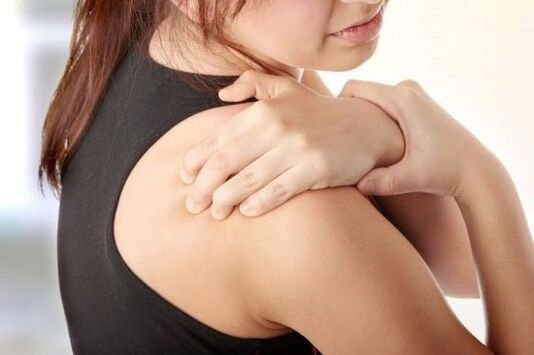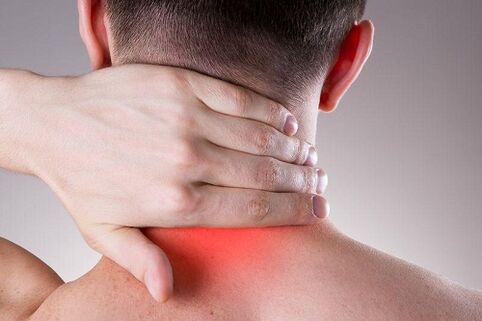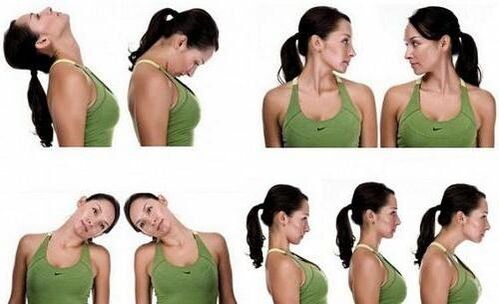Osteochondrosis of the cervical spine (shopping) is one of the most common pathologies of the musculoskeletal system.Each year, doctors diagnose this disease more and more and it lasts more and more severely.According to statistics in women, degenerative dystrophic changes in the upper spine are more common, especially for patients in the period after the fertilization period.The main symptoms of cervical osteochondrosis in women are pain, restriction of mobility, cerebrovascular failure, and this is dangerous not only to health but also to life.To prevent the dangerous effects of the pathology, you should start treating it in the early stages.It is important to perform comprehensive therapy, change lifestyle in order to stop the destruction of vertebrates and prevent serious complications.
The development of the disease
The spine is most vulnerable to various injuries and degenerative changes.This is due to the fact that this segment is the most mobile and the muscles here are weak.Small cervical vertebrae daily withstand a high load, leading to the gradual destruction of the intervertebral discs.The vertebrae are pressed against each other, which causes the cartilage seals between them to lose a lot of liquids, begin to break down and deform.
In addition, osteochondrosis of the cervical spine develops due to insufficient cartilage nutrition.And the spinal canal in this area is narrow, so it is often pulled out, causing neurological symptoms.
Pathology in women in the early stages is manifested by the weight in the back of the head, tingling in their hands, etc.Often patients confuse the first signs of fatigue disease.
A large number of blood vessels and nerve roots are located on the neck area, and neurological disorders can also occur with their compression.It is especially dangerous if the deformed disc or vertebrae compresses the spinal artery, which nourishes important parts of the brain.During his compression, the coordination of movements is disrupted, the woman may lose her balance, her vision, and the hearing is worsened and the risk of increasing stroke.
Reference.According to statistics, cervical osteochondrosis is most commonly found in patients from 25-40 years.This is due to a reduction in the mass of physical activity, the work of sitting.In women, a disease is more common than in men as they have more fragile vertebrae and thin bone tissue.
Doctors distinguish 4 stages of the osteochondrosis store:
- Stage 1 - the intervertebral disc loses some of the moisture, its height decreases, the cracks can appear on the fibrous ring (outer sheath).This is the stage of cervical chondrosis, which is difficult to detect as there are unexplained symptoms.The neck is quickly tired, discomfort, heaviness in the damaged area occurs, sometimes a slight pain occurs, which quickly passes.
- 2 stages - cracks on the surface of the increase of the disc, the pulpal core (gel -like content of the disc) is displaced and can protrude through damaged areas.This shows the convexity of cartilage, which can compress the spinal cord and its roots.Periodically, pronounced pain, weakness, restriction of mobility, numbness of the face, neck, shoulders, arms may occur.
- Stage 3 - The convexity is torn from the outer sheath of the disc, so that the hernia is formed.The pain becomes more pronounced, there are neurological disorders.
- Stage 4 - The disc is almost completely destroyed, their parts appear against each other, the bones (osteophytes) appear, which are intended to stabilize the damaged segment.Nerve endings, spinal cord, blood vessels are impaired.The adjacent joints begin to be damaged.Clinical signs are pronounced.
It is easiest to stop degenerative dystrophic changes in the first two stages of Chop osteochondrosis.At 3 stages, comprehensive treatment will help to stop the more destruction of the spinal segment.In the last stage you cannot do without surgery.
Reasons
Schop osteochondrosis is a complex and prolonged process that most often has several reasons.In most cases, the pathology occurs due to a sedentary lifestyle, malnutrition and metabolic disorders.Often the disease occurs due to injuries or due to the natural aging of the body and the weakening of its defenses.
Doctors distinguish the main causes of osteochondrosis in women:
- Disruption of metabolic processes.
- A passive lifestyle.
- Genetic predisposition.
- Chronic muscle tension around the cervical segment.
- Bending with stand.
- Liquid and nutrients in the body.
- Long -term uncomfortable stay (the neck extends forward and hunched back).
- Excessive weight.
- Frequent wearing of heels.
- Disabilities of the store.
- Lift heavy objects.
- Autoimmune pathologies.
- Common work, chronic fatigue.
- Hypothermia.
- Infectious diseases.
- Too long or short neck, etc.
All these factors cause a violation of the nutrition of the intervertebral discs and lead to their degeneration.
Female cervical osteochondrosis can be caused by pathologies of the spinal artery associated with genetic predisposition, intrauterine disorders, injuries at birth.The disease can occur due to rheumatism, endocrine disorders, excessive loading of the cervical segment during pregnancy, local overloads.
Important.The main causes of cervical osteochondrosis in women are menopause, as well as changes associated with this period.At this stage, the concentration of progesterone is reduced in the body, which is very important for bone tissue.The likelihood of degenerative changes is related to the weakening of the age of the neck muscles and the weakening of the vertebral support in this area.
Symptoms
Osteochondrosis is characterized by a wave -like course when the acute period is replaced by remission.Exacerbation can provoke infections, injuries, hypothermia, long strain on the neck.

The first signs of cervical osteochondrosis in women are headaches, discomfort, weight in the neck.It is important to distinguish time in order to distinguish the pain for chondrosis from migraine or autonomous dysfunction.
Clinical manifestations of osteochondrosis in women are caused by neurological syndromes:
- The cervical discs occur with irritation of nerve endings with fragments of damaged cartilage application.Then a specific crunch appears in the neck, which becomes more pronounced when the head moves after sleep.
- The staircase syndrome becomes the result of damage to the vessels and nerves of the shoulder plexus and subclavian artery.This symptomatic complex is accompanied by pain from the inner surface of the shoulder to the arm from the damaged side.The limb becomes pale, cool, edematous, numbness occurs.Neck pain spreads to the back of the head when the patient rotates his head.
- Syndrome of shoulder periatrosis - dystrophic changes affect the tendon fibers that surround the shoulder.The painful neck sensations radiate to the shoulder and the shoulder are up.There is a forced position of the neck - it is tilted in the affected side and the shoulder is slightly lowered.
- Spinal artery syndrome - fragments of the blood vessel compresses fragments of a damaged disc or osteophyte (depending on the stage of the disease).The patient also rotates headache, nausea, sometimes vomiting occurs.The pain is localized in the back of the head, crown and temples.
- Cardiac - the nerve rays of the spinal cord are damaged.There is heart pain, arrhythmia.In the case of C3 damage, pain in half of the neck occurs, the tongue swells, the patient cannot chew food normally.If the C4 is injured, then discomfort occurs in the area of shoulder greenery, collarbone, heart.With damage to the C5, the reaction of neck pain spreads to the shoulder, the inner surface of the shoulder.The irritation of the C6 manifests itself from the pain from the neck and shoulders to the shoulder and spreads all over the arm to the thumb.If the C7 is damaged, the pain syndrome extends to the back of the shoulder greenery, grabs the entire arm, including the index and the middle finger.When compressing the C8, the pain spreads from the affected area in the elbow and the little finger.
Also, a woman can be disturbed by the emotional sphere, weakness arises, becomes anxious, touching.Often there is insomnia, memory weakens, attention due to regular headache.
Symptoms of cerebrovascular circulation disorders appear when the woman sharply tosses her back, tilts it or performs work in which her hands and cervical spine are loaded, for example, when she digs, draws the ceiling, tolerates weight.
Disruption of cerebral circulation is manifested by dizziness, shaken gait, "flies" in front of the eyes, tinnitus, weakness, nausea.In some patients, the voice becomes hoarse, sometimes disappearing, sore throat occurs.
Osteochondrosis during the menopause period is accompanied by migraine, enhanced by the sweating of the body in the area between the neck and shoulders.In compression of the spinal artery, the work of the cardiovascular system is impaired.
If the disease occurs for a long time, then there is no circulation of important centers that perform neuro-endocrine functions.Due to the increased permeability of the vascular walls, atherosclerosis of the brain and cardiac arteries develops.

Diagnosis
If you notice the symptoms of osteochondrosis, go to the therapist.After visual inspection, the specialist will direct you to an orthopedist, vertebologist or neurologist.
The following methods are used to diagnose cervical osteochondrosis:
- X -ray allows you to understand that the patient has the vertebrae in the patient, the osteophytes are present at their edges, the distance between the vertebrae has decreased.For this, the study is conducted in various aircraft.To detail the characteristic changes, the doctor takes directed pictures.
- The ct of the cervical department provides detailed information on pathological changes in the vertebrae.This method allows you to receive volumetric photos for a more detailed study, it is used in severe diagnostic cases.
- MRI is used to accurately assess the condition of the soft tissues (nerves, blood vessels, ligaments, muscles) on the affected area.
- Electromyography allows you to check the conductivity of nerve fibers.
Doctors may also prescribe UZDG (ultrasound Doppler of the main arteries of the brain) to determine the blood flow in this area.
Conservative treatment
In the early stages, treatment with Chop osteochondrosis in women can be performed at home.However, a doctor should be made up of a doctor.It is important to understand that it is a long process and is unlikely to be completely cured (especially older women).
The composition of complex treatment includes:
- Take medication.
- Use of orthopedic devices.
- Therapeutic gymnastics.
- Physiotherapy procedures.
- Massage, manual exposure.
- Alternative treatments.
Conservative techniques will help stop pain, inflammation, normalize muscle tone, improve metabolic processes, nutrition of damaged segments of the spine.Timely therapy may stop pathological changes.

Cervical osteochondrosis drugs will help get rid of inflammation and pain.
Treatment of cervical osteochondrosis in women is performed with the help of medicines that will help to improve the metabolism of cartilage seals between the vertebrae, stopping inflammation, pain.The following medicines are used for this purpose:
- Nsaid.The inflammation and pain of mild or medium force will help relieve.
- Analgesics.Stop the pain syndrome.
- Preparations to improve cerebral circulation.
- Musodias help eliminate muscle spasm.
- Chondroprotectors.They help to stop the destruction of discs, improve metabolic processes, accelerate recovery.
- Medicines based on greatness.
- Nootropes.They stimulate the functioning of the brain due to the normalization of its blood circulation, have a slight sedative effect.
Reference.With intense pain, which is not stopped by oral drugs, a therapeutic blockade is used, such as a novocaine solution or NSAIDs.
You can supplement the treatment with anti -inflammatory and painkillers in the form of gels, creams and ointments.They will be effective in the remission stage or in combination with oral agents.
The decision to choose medicinal combinations is taken by the doctor.The specialist will compile a diagram for medication and will also determine their dose.It is important to follow his recommendations as many of the above medicines threaten dangerous complications.
During the acute stage of osteochondrosis, the woman should abandon heavy physical activity.To unload the cervical segment, you need to wear a special corset (collar Shantsa) that will fix the vertebrae in the correct position.This device is recommended to be used for a long meeting or firm physical work.
Physiotherapy procedures will help weaken pain and improve blood circulation in the damaged area:
- Diadinamotherapy.
- Magnetotherapy.
- Electrophoresis.
- Electroalgesia.
- UV radiation, etc.
The therapeutic effect is manifested after the third session, then headache, auditory disorders, vision, dizziness, sleep and the general condition improves or disappears.
Using the underwater grip of the cervical segment, you can extend the distance between the vertebrae, release the nerve or blood vessel from compression and restore the normal position of the vertebrae.
Massage will normalize muscle tone, reduce the flow of lymphatic fluid, which causes swelling.After several sessions, blood circulation in the damaged area improves.

Therapeutic gymnastics is one of the most effective methods for treating CHOP osteochondrosis.LFK allows you to strengthen the weak neck muscles, which will then absorb some of the load from the spine and help stop or slow down degenerative dystrophic changes.During the hours, blood circulation improves, metabolic processes, the discs accelerate, which has a positive effect on their condition.
Women have to conduct training every day.They consist of simple but effective exercises.The complex consists of turns, slopes of the head in different directions, as well as movements of the neck, during which they use the hands.These elements can be made at home, but only after the doctor's permission.Medical physical education is performed only at the stage of remission.
Complex treatment can be supplemented with reflexology (acupuncture), hirudotherapy (leech treatment), swimming, etc.
Surgical treatment
The surgery is prescribed in the last stages of CHOP osteochondrosis, which are accompanied by the serious destruction of bone structures.Also, surgery cannot be done if conservative methods were ineffective or spinal canal significantly narrowed.
In the above cases, anterior cervical discoctomy is performed.During the procedure, the doctor immobilizes the damaged segment of the spine and eliminates the hernia that squeezes the spinal nerve.Then the vertebrae are consumed, between which the disc is removed.If necessary, the space between the vertebrae is filled with a synthetic insert (cell).
After 3-5 days, the patient is released at home.The rehabilitation period is about 12 weeks.To accelerate recovery, you need to take medication, wear a corset, lead the right lifestyle, go to physiotherapy procedures, and perform exercise therapy over time.
Life recommendations
In order to get rid of the unpleasant symptoms of osteochondrosis quickly and stop degenerative dystrophic changes in the cervix segment, you need to adjust the lifestyle.For this, the patient should follow the following recommendations:
- Go to tourism every day, avoid running, jumping and other explosive stress.
- You can't wear heavy items.
- You cannot sit for a long time, in extreme cases, wear a corset and periodically occupy a horizontal position.
- Do special exercise for the posterior muscles at home.
- He sleeps on an orthopedic mattress and a special pillow.
- Follow the diet, fill the diet with products rich in magnesium, calcium (nuts, dairy products, seafood, legumes), as well as plant fiber, chondroitin (jelly, jelly).Refuse fatty, fried, too salty food, alcohol.Read more about the power rules will be advised by the doctor.But in any case it should be correct.
Numbering cannot be allowed, warming will benefit in the absence of an inflammatory process.
Complications
In the absence of timely treatment of cervical osteochondrosis, a woman may feel the following consequences of the pathology:
- The likelihood of a convexity arises, which after a while is transformed into hernia.The pushes compresses the spinal cord as well as its nerves, causing neurological disorders.
- Osteophytes occur with severe discomfort, they irritate the spinal nerves and blood vessels.
- In advanced cases, a severe weakening of the neck muscles or incomplete paralysis is possible, and then the head involuntarily hangs away or forward.
- Compression of the spinal arteries, circulatory disorders in the affected area.This condition can cause neuralgia (pain along the nerve), hearing impairment and vision.
- Paralysis (incomplete or full) hands.
- Stroke.
If a woman is dealing with the problem in the early stages of store osteochondrosis, she will be able to alert the above conditions.
Preventive measures
Ideally, the prevention of CHOP osteochondrosis is required during the intrauterine development period.The expectant mother should exclude factors that negatively affect the development of the fetus: infections, oxygen starvation, intoxication.If there is a birth injury, then the newborn should be treated.
In order to reduce the likelihood of developing CHOP osteochondrosis, the woman must follow the following recommendations:
- Stop the spine evenly, for example, carry a load in both hands or in turn to the right and then to the left.
- Do not lift too much weight.
- Try to avoid injuries to your neck, hypothermia.
- While working in garden areas, take a break every 1.5 hours, go to rest for 20 minutes.
- Choose shoes with an elastic outsole that will soften hit while running or jumping.
- With a long seat, use a chair with a tall back and back or put on a corset.
It is also important to eat, control weight, avoid stress, take vitamin preparations for medical reasons, treat pathologies in a time, which can cause osteochondrosis.At the remission stage, it is recommended that you visit sanatoriums to undergo a course of treatment.
The most important thing
As you can see, in women, osteochondrosis of the cervical spine is more common than in men, as the former have more fragile vertebrae and thin bone tissue.Patients are particularly susceptible to patients in the post -climacteric period.The disease is manifested by pain, neurological disorders, as well as dangerous symptoms of cerebral disaster.It is recommended that treatment start in the early stages to avoid dangerous complications of osteochondrosis.To do this, a woman must take medication, adjust lifestyle, attend physiotherapy procedures, massage, do physiotherapy exercises.Surgical treatment is indicated only in advanced cases.To prevent pathology, you need to monitor moderate physical activity, treat injuries and diseases that can provoke osteochondrosis on time.

























































































